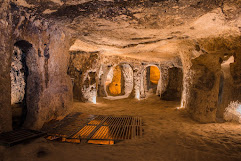Mysterious underground labyrinths of nature
Underground labyrinths are fascinating and mysterious places that have excited the human imagination for centuries. These natural wonders can be found all over the world and are impressive in their scale, beauty and complexity. In this article, we'll explore some of nature's most famous underground labyrinths, learn how they were formed, and share our thoughts on their significance.
Where to find underground labyrinths:
Mammoth Caves-Flint Ridge: This cave system in the United States is the longest in the world, with more than 400 miles of passages.
Waitomo Caves: These caves in New Zealand are famous for their glow worms, which create a spectacular sight.
Cappadocia Caves: These caves in Turkey have been carved into soft volcanic rock for centuries and have been used as dwellings, churches and monasteries.
Melbourne Underground Labyrinth: This maze of tunnels and chambers in Australia was created when the city was built and is now used for guided tours.
How underground labyrinths are formed:
Erosion: Water flowing through rock over millions of years can erode caves and other underground spaces.
Karst phenomena: Some types of rock, such as limestone, are dissolved by water, which can lead to the formation of caves and tunnels.
Tectonic activity: Earthquakes and other geological events can lead to the formation of cracks and faults in the earth's crust, which can eventually turn into underground labyrinths.
Thoughts on the meaning of underground labyrinths:
Scientific value: Underground labyrinths can give us valuable information about the geological history of the Earth and how it was formed.
Aesthetic value: These natural wonders are impressive in their scale, beauty and complexity.
Cultural Value: Many underground labyrinths have cultural significance for local residents.
Recreational value: These places are popular tourist destinations that offer unique experiences to visitors.
Underground labyrinths are fascinating and mysterious places that offer us a unique view of the geological history of the Earth and its natural wonders.




Comments
Post a Comment